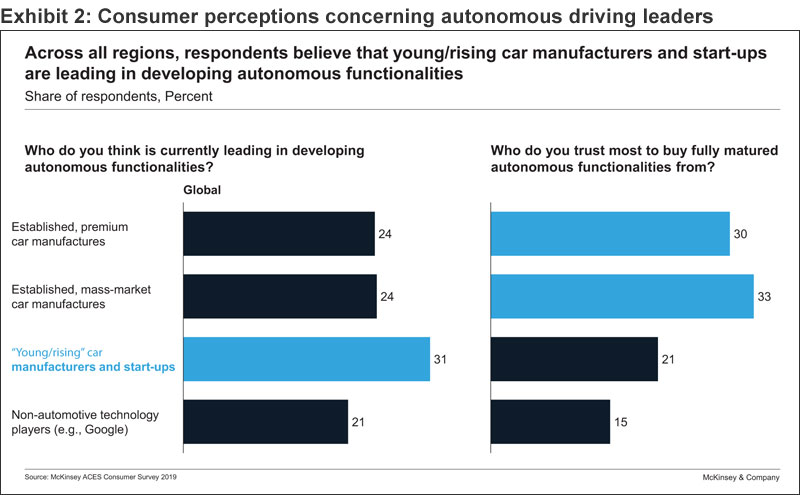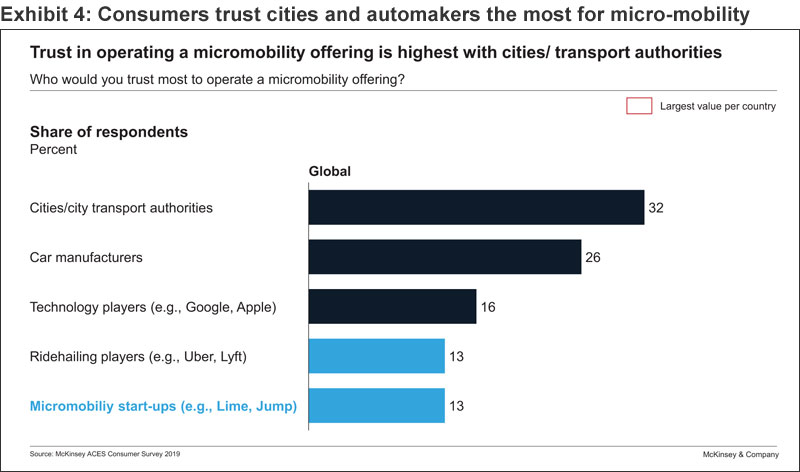Mobility and how the world gets around is changing—and three facts are driving this transformation more than anything else. First, the technology is advancing strongly, with over 300 new electric vehicle models slated to debut by 2025, for example. Second, new business models are redrawing the mobility market. The total number of shared micromobility trips via shared e-scooters, e-bikes and e-mopeds, for example, rose from 35 to more than 80 million globally from 2017 to 2018. And third, consumer mobility preferences are changing dramatically; in the UK alone, fewer than 30% of young men between the ages of 17 and 20 have driver’s licenses, compared with more than half in the mid-1990s.
Unicorns take the field
These changes have enabled the entrance of new players—start-ups, including unicorns (start-ups worth US$1bn or more) are beginning to reshape the future of mobility as they work beside established automakers, suppliers, and tech companies.

To gain deeper insights into the role of start-ups in the automotive industry, we investigated the issue using two different lenses. The first looks at investments focused on the four ACES megatrends—automated driving, connectivity, vehicle electrification and shared mobility—through our Start-up and Investment Landscape Analysis (SILA) database. Each of these trends tends to attract different types of players. For example, technology start-ups typically focus on automated driving, connectivity, and electrification, where intellectual property innovation predominates and the next big breakthroughs—in sensors, software, or battery technology, for example—could point the way to success. New business model start-ups mainly concentrate on shared mobility.
Second, one can also analyse consumer opinions and sentiments toward new mobility start-ups as per our ACES market survey.
Mobility start-ups attract interest and cash
What’s unusual about this revolution is the massive amount of cash pouring into mobility start-ups. Since 2010, investors have bet more than US$220bn in over 1,100 mobility start-ups, with more undoubtedly on the way. In fact, the average yearly investment across all ACES technologies jumped sevenfold in the periods 2010-2013 and 2014-2018.

Consequently, mobility start-ups are becoming more expensive. Even the median investment amount for relatively smaller deals (those involving less than US$100m in investment volume) has increased two to three times since 2013.
Regionally, over a third of the overall investment in mobility went to companies in the US, followed by China (>US$50bn). In Europe, start-ups in the UK attract the most money (>US$30bn). Overall, most of the spending goes to a few large companies and unicorns, such as Uber, Lyft, and Mobileye. Automakers have also acquired some unicorns, especially in the autonomous driving space, where their capabilities complement those of established players. Examples include Argo AI and Cruise Automation.
The market has seen a strong investment acceleration among e-hailing players, driven mainly by large investments in top players like Uber, Lyft, and Grab (Exhibit 1). Investors have targeted over US$56bn since 2010 for this area, with average investments increasing more than 50 times between the periods 2010-2013 and 2014-2018.

Furthermore, shared micromobility start-ups have gained traction in recent months. Total investments already exceed US$1bn, with an average investment of over US$100m per transaction. Non-automotive players are driving this influx, together with venture capitalists and private equity firms. Overall, VC and PE players as well as tech firms are responsible for up to 90% of the investments in the mobility space.
Tapping into what consumers think
In our ACES market survey, we investigated consumer opinions and sentiments on mobility from over 7,000 respondents in seven countries—China, France, Germany, India, Italy, Japan, and the US.
Consumers currently believe that “young car companies and start-ups” are leading in the development of autonomous driving functionalities; a sentiment that has increased by 16 percentage points in the US, from 29% in 2017 to 45% in 2019 (Exhibit 2). Even so, most consumers would still trust established automakers more when purchasing a self-driving car.
The same holds also true for electric vehicles (Exhibit 3) where 37% of all respondents think that “young/rising stars” are leading in the development of electric vehicles but 68% would trust established car manufacturers to buy one (thereof, 27% premium and 41% mass market). Here, the acceleration is again strongest in the US. Looking on the development over time, the number of consumers who see start-ups and “young rising stars” taking the lead in electric vehicle development moved from 36% in 2017 to 48% in 2019 in the US.

In the new market for shared micro-mobility, which includes shared e-scooters, consumers trust start-ups the least to operate such services, instead preferring cities and established car manufacturers (Exhibit 4). This is despite the fact that start-ups are the main actors today in these markets.
Ultimately, start-ups, as well as automakers, suppliers and tech companies must work together, given that both bring unique capabilities to the table. Start-ups provide the innovative horsepower to drive many of these new markets, while the others provide the industry expertise and consumer trust required to build scaled-up, value-generating, sustainable positions.
Perhaps the best evidence of the transformation taking place in the automotive industry resides in the floodtide of cash flowing to start-ups and unicorns. In the past, these organisations played ancillary roles in the sector. Now, they’ve moved closer to centre stage, promising solutions to some seemingly intractable disruptions and offering innovations in everything from advanced technology to business models. The days when mobility and automotive sector investments received lukewarm interest from the financial markets are over.
About the authors: Daniel Holland-Letz is an analyst in McKinsey’s Munich office, where Matthias Kässer is a partner; Benedikt Kloss is a consultant in the Frankfurt office; and Thibaut Müller is an associate partner in the Geneva office
This article is taken from Automotive World’s December 2019 ‘Special report: Who are the mobility start-ups and unicorns to watch in 2020?‘, which is available now to download
